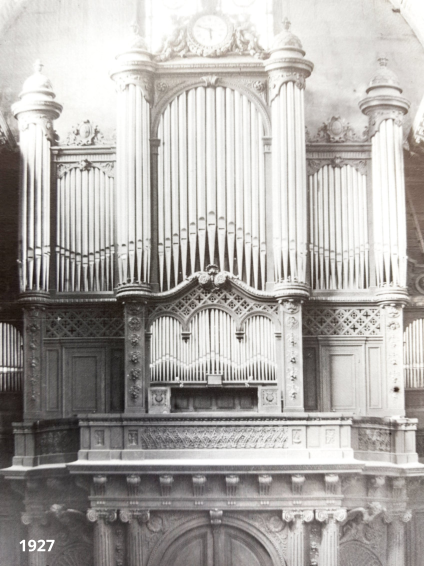


ORGANS OF PARIS © 2025 Vincent Hildebrandt HOME ALL ORGANS


B2
Before the Revolution, the church had an organ, but no
document survives on the circumstances during which the
church was dispossessed of its organ before the Concordat.
Its characteristics are unknown. In 1763, the instrument
was maintained by Claude Ferrand. This organ disappeared
during the French Revolution, around 1793.
After the Concordat, an organ accompaniment made by
organbuilder Larroque was installed in the choir of the
church. In 1831, Louis Callinet began the construction of a
large organ.
In 1864, Joseph Merklin was commissioned to transfer the
instrument to the current gallery, which was made up of
eighteenth-century elements. The mechanics, windchests
and wind tunnel were redone. Some detail stops and Plein-
Jeux were also removed. The work was completed in 1867.
In 1910, John-Albert Abbey abolished all mutation stops;
the organ is reduced to 25 stops.
In 1925, the instrument was restored and enlarged by
Auguste Convers. The instrument is increased to 32 stops.
The order of the keyboards was changed with the G0 in the
first position. The Positive became expressive, a Barker
machine at the GO was set up and a tubular pneumatic
transmission for the Swell was installed.
In 1962, following the bombings of 26 August 1944, during
which the instrument was badly damaged, a reconstruction
of the instrument in North German style was entrusted to
Alfred Kern. The old case (1864) has been preserved, but its
base has been modified and a back positive case has been
added. Much of Callinet's piping has been preserved. The
console is arranged in a central window and controls a
suspended mechanism. The call of the stops is
electropneumatic, which allowed the installation of two free
combinations.
In 1973, modifications by Afred Kern and Sons.
In 1991, an overhaul by Dominique Lalmand (application of
the Bach-Kellner temperament).

The story of Notre-Dame-des-blancs-Manteaux
begins in the 13th century with the erection of a
convent. The church, in classical style, was built in
1668. During the Revolution, as early as 1790,
religious orders were abolished, monks of the White
Mantles expelled, buildings looted and sold (1796
and 1797). The church was reopened to worship after
the Concordat. In 1863, the architect Victor Baltard
added an eighth span to Rue des Blancs-Manteaux.
As a façade, he relocated the portal of the Church of
the Barnabites, demolished during the drilling of the
Boulevard du Palais.
Artistically, the Church of the White Mantles houses a
surprising number of religious paintings in its nave
and its chapel Sainte-Geneviève. It is also home to a
magnificent German Baroque-style preaching pulpit,
acquired by Father Charles-Félix Garenne, parish
priest of the church from 1831 until his death in 1878
and to whom most of the current furniture is owed.




1968 - Alfred Kern (3)
1973 - Alfred & Daniel Kern (7)
1992 - Dominique Lalmand (6)
III/43 - traction mécanique -
composition

Organs of Paris
ORGANS OF PARIS © 2025 Vincent Hildebrandt ALL ORGANS
B2
Before the Revolution, the church had an organ, but no
document survives on the circumstances during which the
church was dispossessed of its organ before the Concordat.
Its characteristics are unknown. In 1763, the instrument was
maintained by Claude Ferrand. This organ disappeared
during the French Revolution, around 1793.
After the Concordat, an organ accompaniment made by
organbuilder Larroque was installed in the choir of the
church. In 1831, Louis Callinet began the construction of a
large organ.
In 1864, Joseph Merklin was commissioned to transfer the
instrument to the current gallery, which was made up of
eighteenth-century elements. The mechanics, windchests
and wind tunnel were redone. Some detail stops and Plein-
Jeux were also removed. The work was completed in 1867. In
1910, John-Albert Abbey abolished all mutation stops; the
organ is reduced to 25 stops.
In 1925, the instrument was restored and enlarged by
Auguste Convers. The instrument is increased to 32 stops.
The order of the keyboards was changed with the G0 in the
first position. The Positive became expressive, a Barker
machine at the GO was set up and a tubular pneumatic
transmission for the Swell was installed.
In 1962, following the bombings of 26 August 1944, during
which the instrument was badly damaged, a reconstruction
of the instrument in North German style was entrusted to
Alfred Kern. The old case (1864) has been preserved, but its
base has been modified and a back positive case has been
added. Much of Callinet's piping has been preserved. The
console is arranged in a central window and controls a
suspended mechanism. The call of the stops is
electropneumatic, which allowed the installation of two free
combinations.
In 1973, modifications by Afred Kern and Sons.
In 1991, an overhaul by Dominique Lalmand (application of
the Bach-Kellner temperament).

1968 - Alfred Kern (3)
1973 - Alfred & Daniel Kern (7)
1992 - Dominique Lalmand (6)
III/43 - traction mécanique -
composition






















